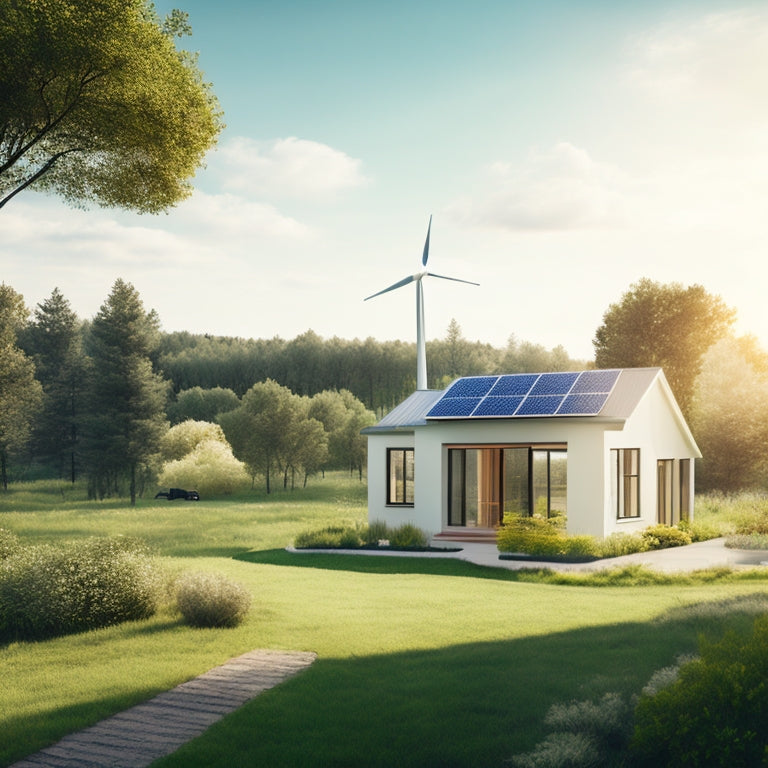
3 Best Solar Energy Savings Strategies
Share
You can maximize your solar energy savings by implementing three key strategies that tackle common inefficiencies in solar panel output, home energy usage, and energy storage. Start by optimizing your solar panel output by ensuring they're properly oriented, cleaning them regularly, and trimming trees to minimize shading. Next, optimize your home's energy usage by upgrading to energy-efficient appliances and evaluating your energy needs through a thorough audit. Finally, leverage energy storage efficiency by selecting the right battery size and technology, and monitoring your energy usage patterns to adjust your storage strategies accordingly. By addressing these areas, you'll be well on your way to revealing even more solar energy savings.
Overview
- Optimize solar panel orientation and cleaning to maximize energy output, as even slight obstructions can reduce production by up to 30%.
- Upgrade to energy-efficient appliances with the ENERGY STAR label to reduce power consumption and optimize home energy usage.
- Utilize advanced battery technology to store excess energy for nighttime or cloudy day use, enhancing energy independence and reducing grid reliance.
- Conduct regular shade mapping analysis to identify and trim obstructions, increasing energy production and saving up to 30% of potential output.
- Implement smart home technology for real-time monitoring and control of energy consumption, enabling data-driven decisions for maximum energy savings.
Maximize Your Solar Panel Output
Most solar panel systems operate at a mere 15% to 20% of their maximum potential, leaving a significant amount of energy untapped.
You can release more power by optimizing your solar panel orientation. Ideally, your panels should face directly at the sun, but this isn't always possible. A south-facing orientation is the next best option.
Conducting a shade mapping analysis shading patterns can help identify areas where trees, buildings, or other obstructions cast shadows on your panels, reducing energy production by up to 30%.
By trimming trees or installing panels in a way that minimizes shading, you can increase energy production. Additionally, consider cleaning your panels regularly to guarantee maximum energy output.
Optimize Your Home's Energy Usage
Efficiency is key to accessing the full potential of your solar energy system. You can optimize your home's energy usage by upgrading to energy-efficient appliances, which consume less power while providing the same functionality.
Look for appliances with the ENERGY STAR label, indicating they meet energy efficiency standards set by the U.S. Environmental Protection Agency.
To further optimize energy usage, it's crucial to assess energy needs through total consumption calculation and energy audit, and then select reliable equipment based on brand comparison and durability.
Smart home technology can also help you monitor and control your energy consumption in real-time, allowing you to make adjustments as needed.
Harness Energy Storage Efficiency
With a well-optimized energy usage strategy in place, you can now turn your attention to utilizing energy storage efficiency.
This involves utilizing advanced battery technology to store excess energy generated by your solar panels during the day for use during the night or on cloudy days. By doing so, you can reduce your reliance on the grid and maximize your energy independence.
Effective energy management is key to achieving this goal, and selecting appropriate battery size and technology is essential in this process. You'll need to monitor your energy usage patterns and adjust your storage strategy accordingly, considering factors such as energy demands and cycle life.
Frequently Asked Questions
Can I Install Solar Panels on a Rented Property?
You can install solar panels on a rented property if your landlord agrees, but consider a solar lease instead, as it allows you to benefit from renewable energy while respecting tenant rights and avoiding property modifications.
Do Solar Panels Work During a Power Outage?
You're wondering if solar panels work during a power outage. Typically, they don't, as they're grid-tied and shut down for safety reasons. However, with energy storage options like batteries, you can maintain solar panel functionality and enjoy backup power during outages.
How Do I Clean My Solar Panels Effectively?
When cleaning your solar panels, you'll want to simultaneously brush off debris, spray with distilled water, and wipe with a soft cloth, ensuring a thorough, gentle cleaning process that enhances energy efficiency through effective solar panel maintenance.
Are Solar Panels Compatible With All Roof Types?
You'll find that solar panels are compatible with most roof types, but it's essential to take into account roof materials and installation angles to guarantee a secure and efficient setup, allowing you to utilize the sun's energy freely.
Can I Sell Excess Energy Back to the Grid?
As you utilize the sun's golden rays, you'll likely generate excess energy; with net metering benefits and energy buyback programs, you can sell it back to the grid, offsetting your bills and embracing financial freedom, one kilowatt-hour at a time.
Ready to Buy
By implementing these three solar energy savings strategies, you'll be well on your way to maximizing your solar panel's potential. Did you know that in 2020, solar energy accounted for 43% of all new electricity generation capacity added in the US? With the right approach, you can join the thousands of homeowners already utilizing the power of the sun to reduce their energy bills and carbon footprint. By maximizing your solar panel output, optimizing your home's energy usage, and using energy storage efficiency, you'll be saving money and the planet in no time.
Related Posts
-

Top Eco-Friendly Camping Equipment for a Sustainable Adventure
When you're camping with the planet in mind, opt for eco-friendly gear like tents made from recycled materials and bi...
-

Solar Phone Chargers for Camping Essentials
Solar phone chargers are must-haves for your camping essentials, allowing you to stay connected while enjoying nature...
-

Smart Grid Technology Implementation Challenges
You'll encounter several challenges when implementing smart grid technology, particularly in cost management, scalabi...


